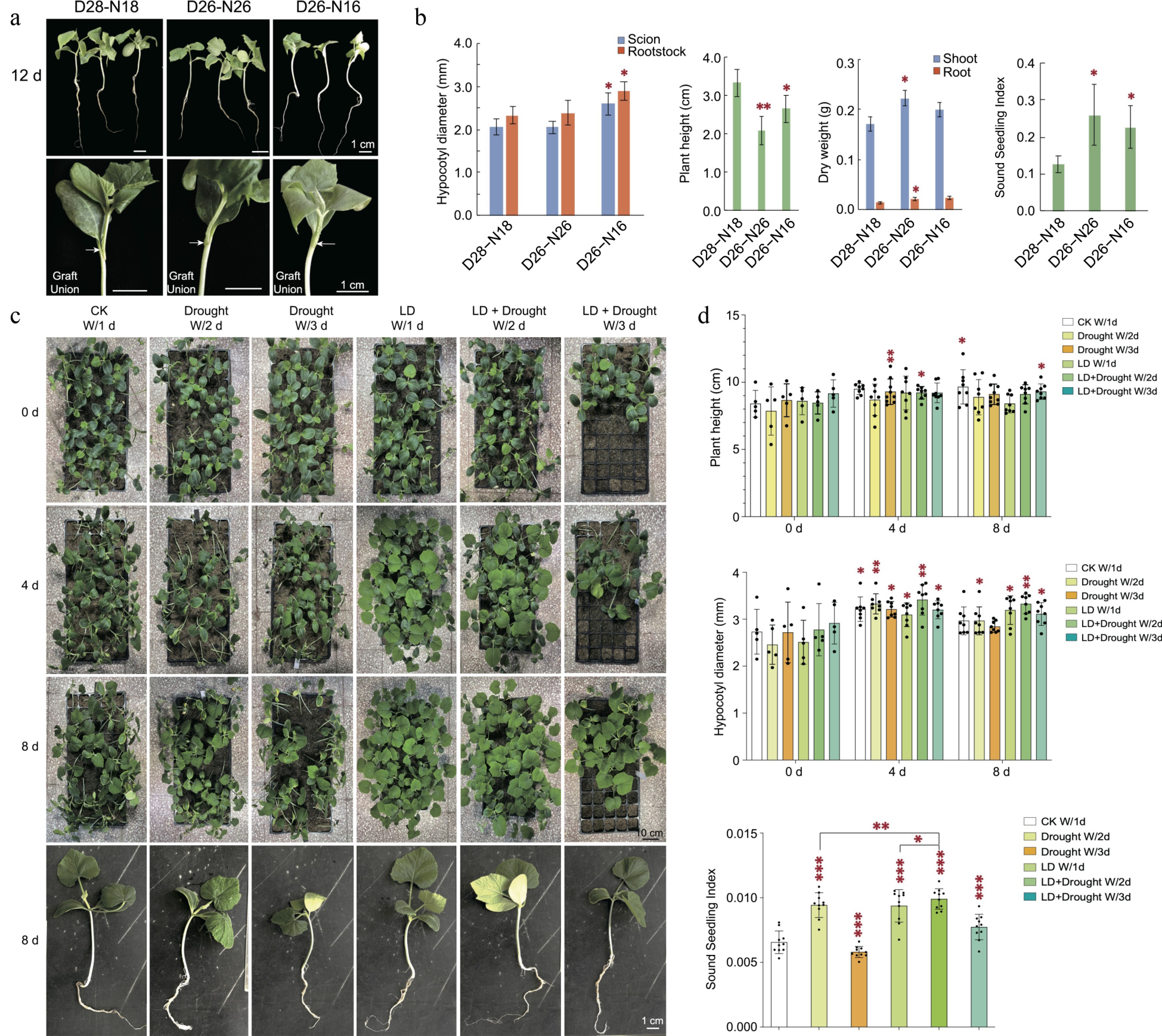-

Figure 1.
TOR-mediated regulation of hypocotyl elongation. (a) Proposed model of TOR in the regulation of hypocotyl elongation. TOR serves as a central regulator that integrates upstream phytohormone signaling and sucrose availability to modulate the BAP (BRASSINAZOLE-RESISTANT (BZR), AUXIN RESPONSE FACTOR (ARF), and PHYTOCHROME INTERACTING FACTOR (PIF)) module, which functions in hypocotyl elongation. BR, brassinosteroid; GA, gibberellin; ROP2, RHO-related protein from plants 2; BIN2, BRASSINOSTEROID INSENSITIVE 2; S6K, Ribosomal-protein S6 kinase; eIF3h, eukaryotic translation initiation factor 3h; ATH1, ARABIDOPSIS THALIANA HOMEOBOX 1. (b), (c) Arabidopsis thaliana ecotype Col-0 as wild type (WT), TOR-RNAi (35-7) line and the triple mutant of ROP2/4/6 (rop2 rop6 ROP4-RNAi) were cultivated on 1/2MS medium under long-day conditions (16 h of light) for 7 d, and treated with combinations of 0.5% sucrose, 0.5 µM AZD8055, or 0.5 µM GA3 for another 3 d in darkness. (b) Hypocotyl lengths and (c) root lengths were quantified from seedling grown on two independent plates. Stars or letters indicate the significant difference (n > 10, one-way ANOVA followed by Student's t-test, two-tailed p < 0.05).
-

Figure 2.
Impact of environmental factors along with water availability on root-shoot relationship and plant growth. (a) 30−50 successfully grafted cucumber (scion)/pumpkin (rootstock) seedlings were cultivated under three distinct conditions: Day26 °C−Night16 °C (D26−N16), Day26 °C−Night26 °C (D26−N26), and Day28 °C−Night18 °C (D28−N18). Graft unions are indicated by arrows. (b) After 12 d, the grafted cucurbits exhibited varying growth characteristics under different conditions. Specifically, the hypocotyl diameter of grafted cucurbits was highest under D26−N16, the plant height under D28−N18, and the dry weight under D26−N26. The sound seedling index (Hypocotyl diameter (mm) / Plant height (cm) * Total dry weight (g)) for D26−N26 and D26−N16 conditions was significantly higher than for other conditions. Statistical analysis was conducted with three replicate pools, each pool comprising 10 individual grafted seedlings. Statistical significance is denoted by stars when compared to the D28-N18 treatment (One-way ANOVA followed by Student's t-test, two-tailed, *** p < 0.001, ** p < 0.01, * p < 0.05). (c) One-leaf-old spindling pumpkin seedlings (Plant height > 4 cm, Stem diameter < 3 mm) were grown at 28 °C/18 °C (day/night) under six different conditions: CK W/1 d, watered with 200 mL/tray once a day, 16 h/8 h day/night; Drought W/2 d, watered with 200 mL/tray once every two days, 16 h/8 h day/night; Drought W/3 d, watered with 200 mL/tray once every three days, 16 h/8 h day/night; LD W/1 d, watered with 200 mL/tray once a day, 20 h/4 h day/night; LD + Drought W/2 d, watered with 200 mL/tray once every two days, 20 h/4 h day/night; LD + Drought W/3 d, watered with 200 mL/tray once every three days, 20 h/4 h day/night. (d) After 8 d, spindling pumpkin seedlings in the LD + Drought conditions exhibited recovery in plant height and hypocotyl diameter compared to the control group (CK). The sound seedling index (SSI) = (hypocotyl diameter/plant height + root dry weight/shoot dry weight) × seedling dry weight. The SSI analysis demonstrated that environmental factors and drought (Drought W/2 d, LD + Drought W/2 d, and LD + Drought W/3 d) effectively promoted plant vigor. Statistical analysis involved 10 replicates, with each replicate comprising three individual seedlings. Statistical significance is denoted by stars when comparing each treatment to its corresponding 0-day control (mean ± s.d., One-way ANOVA followed by Student's t-test, two-tailed, *** p < 0.001, ** p < 0.01, * p < 0.05).
-

Figure 3.
The interplay between m5C modification and TOR signaling in the context of root growth. (a) Both Arabidopsis thaliana ecotype Col-0 as wild type (WT) and m5C writer mutant (dnmt2 nsun2b) were grown on 1/2MS medium containing 0.5% sucrose under long-day condition (16 h light) for 7 d. 0.5 µM AZD8055 was applied to inhibit TOR activity, while 1 µL DMSO was used in mock. (b) Root length was quantified from more than 40 seedlings grown on two independent plates. Statistical difference is indicated by different letters (One-way ANOVA followed by Student's t-test, two-tailed p < 0.05).
Figures
(3)
Tables
(0)